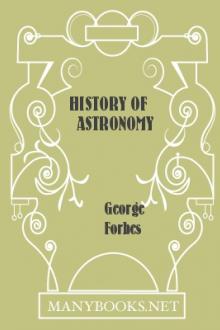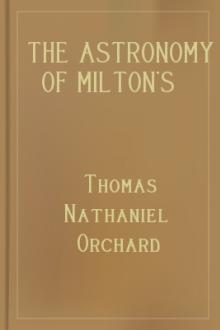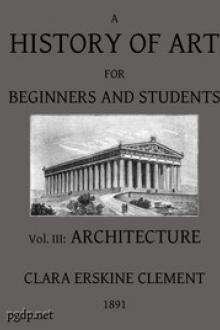History of Astronomy by George Forbes (classic children's novels TXT) 📕

- Author: George Forbes
- Performer: -
Book online «History of Astronomy by George Forbes (classic children's novels TXT) 📕». Author George Forbes
Other nebulæ, and especially the white ones like that in Andromeda, which have not yet been resolved into stars, show a continuous spectrum; others are greenish and give no lines.
A great deal has to be done by the chemist before the astronomer can be on sure ground in drawing conclusions from certain portions of his spectroscopic evidence.
The light of the nebulas is remarkably actinic, so that photography has a specially fine field in revealing details imperceptible in the telescope. In 1885 the brothers Henry photographed, round the star Maia in the Pleiades, a spiral nebula 3’ long, as bright on the plate as that star itself, but quite invisible in the telescope; and an exposure of four hours revealed other new nebula in the same district. That painstaking and most careful observer, Barnard, with 101/4 hours’ exposure, extended this nebulosity for several degrees, and discovered to the north of the Pleiades a huge diffuse nebulosity, in a region almost destitute of stars. By establishing a 10-inch instrument at an altitude of 6,000 feet, Barnard has revealed the wide distribution of nebular matter in the constellation Scorpio over a space of 4° or 5° square. Barnard asserts that the “nebular hypothesis” would have been killed at its birth by a knowledge of these photographs. Later he has used still more powerful instruments, and extended his discoveries.
The association of stars with planetary nebulæ, and the distribution of nebulæ in the heavens, especially in relation to the Milky Way, are striking facts, which will certainly bear fruit when the time arrives for discarding vague speculations, and learning to read the true physical structure and history of the starry universe.
Stellar Spectra.—When the spectroscope was first available for stellar research, the leaders in this branch of astronomy were Huggins and Father Secchi,[24] of Rome. The former began by devoting years of work principally to the most accurate study of a few stars. The latter devoted the years from 1863 to 1867 to a general survey of the whole heavens, including 4,000 stars. He divided these into four principal classes, which have been of the greatest service. Half of his stars belonged to the first class, including Sirius, Vega, Regulus, Altair. The characteristic feature of their spectra is the strength and breadth of the hydrogen lines and the extreme faintness of the metallic lines. This class of star is white to the eye, and rich in ultra violet light.
The second class includes about three-eighths of his stars, including Capella, Pollux, and Arcturus. These stars give a spectrum like that of our sun, and appear yellowish to the eye.
The third class includes alpha Herculis, alpha Orionis (Betelgeux), Mira Ceti, and about 500 red and variable stars. The spectrum has fluted bands shaded from blue to red, and sharply defined at the more refrangible edge.
The fourth class is a small one, containing no stars over fifth magnitude, of which 152 Schjellerup, in Canes Venatici, is a good example. This spectrum also has bands, but these are shaded on the violet side and sharp on the red side. They are due to carbon in some form. These stars are ruby red in the telescope.
It would appear, then, that all stars are suns with continuous spectra, and the classes are differentiated by the character of the absorbent vapours of their atmospheres.
It is very likely that, after the chemists have taught us how to interpret all the varieties of spectrum, it will be possible to ascribe the different spectrum-classes to different stages in the life-history of every star. Already there are plenty of people ready to lay down arbitrary assumptions about the lessons to be drawn from stellar spectra. Some say that they know with certainty that each star begins by being a nebula, and is condensed and heated by condensation until it begins to shine as a star; that it attains a climax of temperature, then cools down, and eventually becomes extinct. They go so far as to declare that they know what class of spectrum belongs to each stage of a star’s life, and how to distinguish between one that is increasing and another that is decreasing in temperature.
The more cautious astronomers believe that chemistry is not sufficiently advanced to justify all of these deductions; that, until chemists have settled the lately raised question of the transmutation of elements, no theory can be sure. It is also held that until they have explained, without room for doubt, the reasons for the presence of some lines, and the absence of others, of any element in a stellar spectrum; why the arc-spectrum of each element differs from its spark spectrum; what are all the various changes produced in the spectrum of a gas by all possible concomitant variations of pressure and temperature; also the meanings of all the flutings in the spectra of metalloids and compounds; and other equally pertinent matters—until that time arrives the part to be played by the astronomer is one of observation. By all means, they say, make use of “working hypotheses” to add an interest to years of laborious research, and to serve as a guide to the direction of further labours; but be sure not to fall into the error of calling any mere hypothesis a theory.
Nebular Hypothesis.—The Nebular Hypothesis, which was first, as it were, tentatively put forward by Laplace as a note in his Système du Monde, supposes the solar system to have been a flat, disk-shaped nebula at a high temperature in rapid rotation. In cooling it condensed, leaving revolving rings at different distances from the centre. These themselves were supposed to condense into the nucleus for a rotating planet, which might, in contracting, again throw off rings to form satellites. The speculation can be put in a really attractive form, but is in direct opposition to many of the actual facts; and so long as it is not favoured by those who wish to maintain the position of astronomy as the most exact of the sciences—exact in its facts, exact in its logic—this speculation must be recorded by the historian, only as he records the guesses of the ancient Greeks—as an interesting phase in the history of human thought.
Other hypotheses, having the same end in view, are the meteoritic hypothesis of Lockyer and the planetesimal hypothesis that has been largely developed in the United States. These can best be read in the original papers to various journals, references to which may be found in the footnotes of Miss Clerke’s History of Astronomy during the Nineteenth Century. The same can be said of Bredichin’s hypothesis of comets’ tails, Arrhenius’s book on the applications of the theory of light repulsion, the speculations on radium, the origin of the sun’s heat and the age of the earth, the electron hypothesis of terrestrial magnetism, and a host of similar speculations, all combining to throw an interesting light on the evolution of a modern train of thought that seems to delight in conjecture, while rebelling against that strict mathematical logic which has crowned astronomy as the queen of the sciences.
FOOTNOTES:
[1] R. S. Phil Trans., 1810 and 1817-24.
[2] One of the most valuable contributions to our knowledge of stellar parallaxes is the result of Gill’s work (_Cape Results_, vol. iii., part ii., 1900).
[3] Taking the velocity of light at 186,000 miles a second, and the earth’s mean distance at 93,000,000 miles, 1 light year=5,865,696,000,000 miles or 63,072 astronomical units; 1 astronomical unit a year=2.94 miles a second; and the earth’s orbital velocity=18.5 miles a second.
[4] Ast. Nacht., 1889.
[5] R. S. Phil. Trans., 1718.
[6] Mem. Acad. des Sciences, 1738, p. 337.
[7] R. S Phil. Trans., 1868.
[8] R.S. Phil Trans., 1783.
[9] See Kapteyn’s address to the Royal Institution, 1908. Also Gill’s presidential address to the British Association, 1907.
[10] Brit. Assoc. Rep., 1905.
[11] R. S. Phil. Trans., 1803, 1804.
[12] Ibid, 1824.
[13] Connaisance des Temps, 1830.
[14] R. A. S. Mem., vol. xlvii., p. 178; Ast. Nach., No. 3,142; Catalogue published by Lick Observatory, 1901.
[15] R. A. S., M. N., vol. vi.
[16] R. S. Phil. Trans., vol. lxxiii., p. 484.
[17] Astr. Nach., No. 2,947.
[18] R. S. E. Trans., vol. xxvii. In 1901 Dr. Anderson discovered Nova Persei.
[19] Astr. Nach., No. 3,079.
[20] For a different explanation see Sir W. Huggins’s lecture, Royal Institution, May 13th, 1892.
[21] For the early history of the proposals for photographic cataloguing of stars, see the Cape Photographic Durchmusterung, 3 vols. (_Ann. of the Cape Observatory_, vols. in., iv., and v., Introduction.)
[22] R. S. Phil. Trans., 1850, p. 499 et seq.
[23] Ibid, vol. cliv., p. 437.
[24] Brit. Assoc. Rep., 1868, p. 165.
INDEX
Abul Wefa, 24 Acceleration of moon’s mean motion, 60 Achromatic lens invented, 88 Adams, J. C., 61, 65, 68, 69, 70, 87, 118, 124 Airy, G. B., 13, 30, 37, 65, 69, 70, 80, 81, 114, 119 Albetegnius, 24 Alphonso, 24 Altazimuth, 81 Anaxagoras, 14, 16 Anaximander, 14 Anaximenes, 14 Anderson, T. D., 137, 138 Ångstrom, A. J., 102 Antoniadi, 113 Apian, P., 63 Apollonius, 22, 23 Arago, 111 Argelander, F. W. A., 139 Aristarchus, 18, 29 Aristillus, 17, 19 Aristotle, 16, 30, 47 Arrhenius, 146 Arzachel, 24 Asshurbanapal, 12 Asteroids, discovery of, 67, 119 Astrology, ancient and modern, 1-7, 38
Backlund, 122 Bacon, R., 86 Bailly, 8, 65 Barnard, E. E., 115, 143 Beer and Mädler, 107, 110, 111 Behaim, 74 Bessel, F.W., 65, 79, 128, 134, 139 Biela, 123 Binet, 65 Biot, 10 Bird, 79, 80 Bliss, 80 Bode, 66, 69 Bond, G. P., 99, 117, 122 Bouvard, A., 65, 68 Bradley, J., 79, 80, 81, 87, 127, 128, 139 Bredechin, 146 Bremiker, 71 Brewster, D., 52, 91, 112 Brinkley, 128 Bruno, G., 49 Burchardt, 65, 123 Burnham, S. W., 134
Callippus, 15, 16, 31 Carrington, R. C., 97, 99, 114 Cassini, G. D., 107, 114, 115, 116, 117, 118 Cassini, J., 109, 129 Chacornac, 139 Chaldæan astronomy, 11-13 Challis, J., 69, 70, 71, 72 Chance, 88 Charles, II., 50, 81 Chinese astronomy, 8-11 Christie, W. M. H. (Ast. Roy.), 64, 82, 125 Chueni, 9 Clairaut, A. C., 56, 63, 65 Clark, A. G., 89, 135 Clerke, Miss, 106, 146 Comets, 120 Common, A. A., 88 Cooke, 89 Copeland, R., 142 Copernicus, N., 14, 24-31, 37, 38, 41, 42, 49, 128 Cornu, 85 Cowell, P. H., 3, 5, 64, 83 Crawford, Earl of, 84 Cromellin, A. C., 5, 64
D’Alembert, 65 Damoiseau, 65 D’Arrest, H. L., 34 Dawes, W. R., 100, 111 Delambre, J. B. J., 8, 27, 51, 65, 68 De la Rue, W., 2, 94, 99, 100, 131 Delaunay, 65 Democritus, 16 Descartes, 51 De Sejour, 117 Deslandres, II., 101 Desvignolles, 9 De Zach, 67 Digges, L., 86 Dollond, J., 87, 90 Dominis, A. di., 86 Donati, 120 Doppler, 92, 129 Draper, 99 Dreyer, J. L. E., 29,77 Dunthorne, 60 Dyson, 131
Eclipses, total solar, 103 Ecphantes, 16 Eddington, 131 Ellipse, 41 Empedocles, 16 Encke, J. F., 119, 122, 123, 133 Epicycles, 22 Eratosthenes, 18 Euclid, 17 Eudoxus, 15, 31 Euler, L., 60, 61, 62, 65, 88, 119
Fabricius, D.,95, 120, 121 Feil and Mantois, 88 Fizeau, H. L., 85, 92, 99 Flamsteed, J., 50, 58, 68, 78, 79, 93 Fohi, 8 Forbes, J. D., 52, 91 Foucault, L., 85, 99 Frauenhofer, J., 88, 90, 91
Galilei, G., 38, 46-49, 77, 93, 94, 95, 96, 107, 113, 115, 116, 133 Galle, 71, 72 Gascoigne, W., 45, 77 Gauss, C. F., 65, 67 Gauthier, 98 Gautier, 89 Gilbert, 44 Gill, D., 84,





Comments (0)